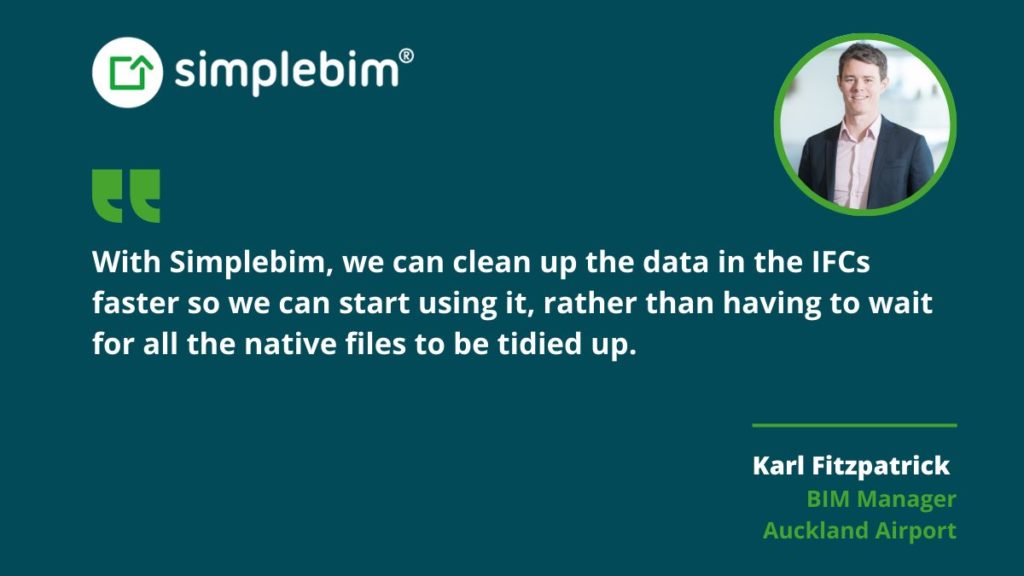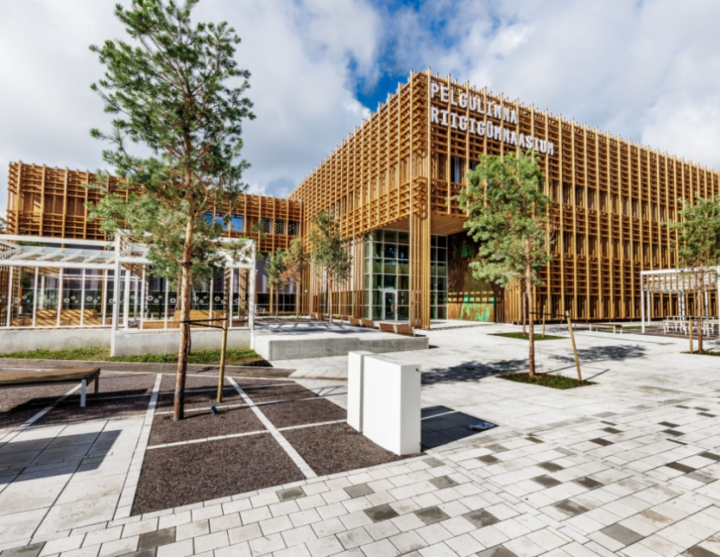How I use Simplebim: Auckland Airport BIM Manager on using Simplebim to streamline maintenance and operations

The largest and busiest airport in New Zealand, Auckland Airport occupies 1,500 hectares of land south of Auckland city centre. A domestic and international hub, pre-covid times, the airport handled over 19 million passengers a year through 30+ international airlines.
With a renewed post-covid expansion and redevelopment planned, the airport is undertaking a complex programme of work involving several large and complex interfacing projects, involving multiple stakeholders, all while having to manage day-to-day operations and maintenance of the facility.
We spoke to Building Information Manager Karl Fitzpatrick about how he is using BIM to supply information to colleagues and external suppliers to facilitate decision-making, and how Simplebim is simplifying and streamlining processes.
How did you discover Simplebim?
Karl Fitzpatrick: I first came across Simplebim and the IFC format 12 years ago when I was working as an architect in Finland. I was used to working with 3D models natively, but everyone was talking about IFCs and co-ordinating with IFCs, which in New Zealand, even now, is still misunderstood.
That was the first time I’d seen other disciplines e.g., HVAC, using 3D modelling. The Finns had already been doing it for a decade before that. So, I felt like I’d come into this world where I’d jumped forward 10 years.
During that period I discovered Simplebim. I found out how it solves the problem of being able to combine and clean up IFC models without always having to go back to the source software.
Simplebim simplifies the task of making models suit your needs, without having to add additional scope to the team creating the original model.
How did you end up using Simplebim at Auckland Airport?
KF: When I was working as an architect in Finland, I realised that architects, and other engineering disciplines, produced a lot of data that would be useful to clients post-construction.
However, at that time, an architect’s focus was on the design and not so much on the facility management aspect of a project. Yet, I really believed the digital information we had could be useful over the lifecycle of the building.
So, when I saw a job opening at Auckland Airport, where they wanted to explore the future of BIM, how it can help with operations and maintenance, in addition to delivering a large programme of capital works, I jumped at the opportunity.
What was your biggest challenge before adopting Simplebim?
KF: Previously, people were producing 3D models, but the process was all a bit uncoordinated, as many models were created at different times and by different firms. Some companies were only adding data that was useful to them. And not all the disciplines were modelling.
Then the data classifications weren’t consistent across models. For example, one building might call it ‘ground floor’ and another call it ‘00’ floor.
So, when you’ve got hundreds of different models, all in their native format, trying to stitch them together can be quite difficult, especially as data often goes missing and the models become very large.
It’s not just as easy as copying and pasting from one file to another, or merging them together, even though it should be that simple.
However, using Simplebim allows us to merge IFC models and to consolidate data, for the purposes of publishing it.
It does not require years of training to become an expert in using BIM authoring tools to manipulate model data to the required standards.
Simplebim is easy to use. It saves us so much time and resource.
How does Simplebim help?
KF: What Simplebim allows us to do is export IFCs from each native file and merge them into one IFC, typically by discipline.
It would take much longer to tidy up all the native models just to get the structure right than it would be to clean up the IFCs for the purpose of publishing data.
With Simplebim, we can clean up the data in the IFCs faster so we can start using it, rather than having wait for all the native files to be tidied up.
It saves us a lot in terms of resource and allows us to get things done faster.
How do you see your use of Simplebim progressing?
KF: I’d like to make more use of the automation functionality. The expectation is that models are coming in structured to our standard. If they did, then we could have a process of automatically merging each discipline into its own discipline model. And then we could have one IFC record of each discipline for each building.
If we could automate a lot of the processes in the background that would be the Holy Grail. We do not want to build up a huge team of people just having to wrangle models. It would be nice to be able to get what we get from the supply chain and have it merged into our world seamlessly.
What is your favourite Simplebim feature?
KF: I like the buckets. I really like how they allow me to just click on something and drag it out of the model or drag it in. That’s one of the features I use the most. I just click on what I don’t want and remove it.
For example, we’ve got designs happening to our existing building which will involve removing some of the old structure. With Simplebim’s bucket feature I can just go in and pick up the old part of the structure, drag it out and then re-export the IFC. It’s so easy.
You mentioned earlier that use of IFCs is still ‘under the radar’ in New Zealand. What do you think needs to change?
KF: The thinking around the use of Open BIM and IFCs needs to change. Many clients think they have to ask for a particular file format, like a proprietary format.
You get people who aren’t BIM experts, but they’re the ones procuring stuff. And they’re asking for native because that’s what they’ve been told they need.
What they don’t realise is that if you work with IFCs, once the building is delivered, you’ve then got that data you can use post-project without complex tools.
Clients can take a leaner approach, as the majority of modelling work is typically done by external suppliers, who are increasingly contracted to deliver structured models.
With a tool like Simplebim, which is affordable and easy to use, clients can edit their own data themselves without having to go and learn a complex BIM authoring tool.
So, it’s more the idea that we can actually reduce the cost of doing BIM for clients, which would then help drive the industry forward because it’d be cheaper for them to manage it themselves.
Ultimately, if clients can take control of their own data it’s a game changer.
Are you ready to take control of your data? Why not book yourself a demo and find out how Simplebim can help you overcome your data management challenges.


